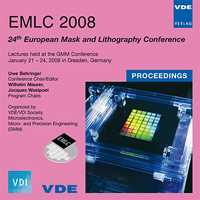Very High Sensitivity Mask DUV Transmittance Mapping and Measurements Based on Non Imaging Optics
Konferenz: EMLC 2008 - 24th European Mask and Lithography Conference
21.01.2008 - 24.01.2008 in Dresden, Germany
Tagungsband: EMLC 2008
Seiten: 11Sprache: EnglischTyp: PDF
Persönliche VDE-Mitglieder erhalten auf diesen Artikel 10% Rabatt
Autoren:
Ben-Zvi, Guy; Dmitriev, Vladimir; Graitzer, Erez; Zait, Eitan; Sharoni, Ofir; Cohen, Avi (Pixer Technology, 44 Maale Camon Karmiel 21613 Israel)
Inhalt:
A key feature of a photomask is the transmission (Tr) property of its many surfaces. Typical advanced 6" masks have 4 surfaces: back side Quartz (Qz), front side pattern, inside pellicle and outside pellicle. In addition to the surfaces themselves, the bulk of the transparent materials- fused silica, fluoropolymers, and MoSi shifter stacks, have specific optical Tr properties which contribute to the total Tr properties of the mask. Surface coating materials such as Cr of varying thicknesses and Anti Reflective (AR) coatings also contribute to the total Tr of the photomask. Overall the wafer printed pattern fidelity to the design depends both on the physical size of the etched lines and spaces and on the Tr properties of the spaces and of the coating material in the lines. The high MEEF values reported in advanced litho processes are most probably affected among other factors by mask Tr properties which may significantly deviate from their ideal Tr values. Factors which may contribute to transmission deviations include contamination on any of the surfaces due to haze growth, contamination by metal and oxide ions absorbed in the Qz and adsorbed on the Qz surface during mask manufacturing, photochemical degradation of the pellicle and fused silica substrates, degradation of absorber thickness (particularly MoSi) due to clean processes, and more. Accumulated contributions of all those factors can give rise to transmission variations of up to several percent. It is well known that every percent of exposure dose change may result in 1-2 nm CD change on wafer depending on exposure and process conditions. All of the above factors raise the need for an advanced transmission measurement system that will be able to measure transmission at the exposure wavelength with sensitivities better than 0.1%, preferably better than 0.01% (100 ppm). Such systems are currently not available. In this paper we describe a DUV Tr measurement system which provides the ability to measure Tr profiles of blanks and patterned masks. The system has a very fast MAM time of less than 1 sec per point and can measure the Tr Uniformity (TRU) profile of a full size mask with 100% coverage in less than 4 hours. The system is very flexible and allows the user to define the density and sensitivity of the measurements in order to suit a particular task. The system measures through pellicle under better than class 1 clean air conditions. The system is distinguishable from existing Tr measurement systems by the fact that it is non imaging, uses an incoherent wide band light source with very high SNR, high sensitivity, and very high stability.


